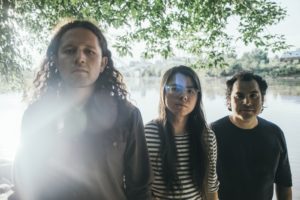The North Saskatchewan river kisiskâciwanisîpiy flows through the heart of amiskwaciy (Edmonton) on Treaty 6 territory. In their new album, nipiy (Cree for “water”), Edmonton-based post-rock/ambient/pop band nêhiyawak echo the pace with which that river flows.
“When we think of nipiy, there is an intellectual and physical resource there that those waters, these rivers, have given our families and I hope that the album speaks to those perspectives,” says nêhiyawak drummer Marek Tyler.
Tyler’s mother reminded him of the importance of understanding the meaning of the word “nipiy” if he was going to use it.
“What does water mean? It’s foundational, it’s most stable at its lowest point, it’s used in teachings, it’s used in ceremony,” he says. “It’s one of the first things I think of when I think of Edmonton.”

The album begins and ends with tracks that represent the river, in name and in tempo. These soundscapes are atmospheric and evocative, carrying a flow into nipiy. And the stories told in nipiy are part of a larger conversation, influenced by the Idle No More movement and the Truth and Reconciliation Commission of Canada.
“There’s a very distinct, unique perspective by Indigenous people in general that Kris [Harper, lead singer] does a fantastic job of capturing and presenting in an informed way,” says Tyler.
The band recorded the soundtrack for the 2017 documentary film otenaw, which focused on Dwayne Donald, an academic who teaches at the University of Alberta. Donald’s teachings found their way into nipiy as well.
“[Donald] spoke to the layers of people and history that have walked through the valley here, and he spoke about the relationship that we’ve had with the water that has flowed through here. It gave us a perspective that we’ve been here, we are here, and we’ll always be here,” says Tyler.
Those elements of history and tradition are also evident in the instruments nêhiyawak used on the album. Recording at the Hive Studios with Colin Stewart, known for producing bands like the New Pornographers and Black Mountain, the band was gifted three drums by Carey Newman, a Kwakwaka’wawk and Sto:lo artist living on Lakwungen territory. The elk hide drum used on the recording was part of Newman’s influential art installation, The Witness Blanket, crafted from items retrieved from residential schools.
“The process of accepting that gift and caring for that drum and using that drum in a good way, that informed the recording,” says Tyler.
The band also made use of a carved cedar log drum, provided by Newman, that recreated the sound of wood on wood from Tyler’s childhood attending pow-wow.
“The sound of it, the tone of it… it’s just stunning,” he says. “It’s what I heard when I was a kid, but it’s a lot more because it was a drum from that territory.”
Navigating an intersection between contemporary and traditional on this album, the band used this opportunity to explore their voices and their sound, and the result is one filled with pride—and at a nêhiyawak show, the audience can expect to feel that pride radiating from the band.
“I’m so proud of who I am and I want to blow on the coals of those good feelings,” says Tyler. “On the west coast, they have a term, Eyēʔ Sqȃ’lewen—that good feeling inside—and I hope that people feel that.”
The pride that Tyler has for their work is vibrant, particularly when describing the brilliance of his bandmates. Community is the heart of nêhiyawak and building that feeling of community is fundamental to their message.
“We’re part of a bigger community, you and me and everyone,” says Tyler, “and whatever we can do to support that, let’s try and do that.”
nêhiyawak
8 pm Friday, December 6
$15, Lucky Bar
luckybar.ca
Correction: This story originally said Carey Newman was a Lekwungen artist living in Victoria; Newman is actually a Kwakwaka’wawk and Sto:lo artist living on Lakwungen territory. We apologize for the mistake.

Correction:
Carey Newman, the artist who gifted drums to the band, is “Kwakwaka’wawk and Stolo,” and LIVES on Lakwungen territory m